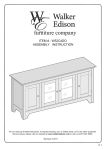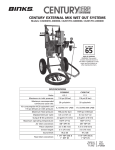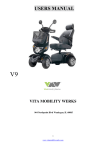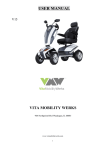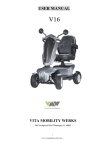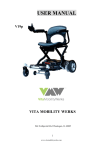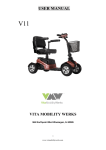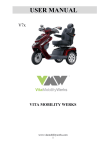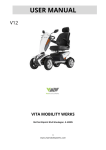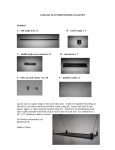Download Service Manual - Whaley Food Service
Transcript
TABLE OF CONTENTS INSTALLATION & OPERATING INSTRUCTION MANUAL FOR MODEL SBC – SLAT BELT CONVEYOR SYSTEM 1. GENERAL INSTALLATION _________________________________________3 1.1. ELECTRICAL FIELD WORK___________________________________________ 3 1.2. BUILDING CONNECTIONS ___________________________________________ 5 1.3. INSTALLATION OF CONVEYOR BELT _________________________________ 5 1.4. INSTALLATION AND REMOVAL OF AEROWERKS SLAT ________________ 5 1.4.1. Installation ________________________________________________________ 5 1.4.2. How to install slats __________________________________________________ 5 1.4.3. Removal __________________________________________________________ 7 2. OPERATION ______________________________________________________7 2.1. SLAT BELT CONVEYOR _____________________________________________ 7 2.2. START AND STOP INSTRUCTIONS ____________________________________ 7 2.2.1. Slat belt wash system ________________________________________________ 8 3. MAINTENANCE ___________________________________________________9 3.1. BEARINGS__________________________________________________________ 9 3.2. CHAIN TAKE UP ____________________________________________________ 9 3.2.1. Slat belt chain ______________________________________________________ 9 3.2.2. Drive chain _______________________________________________________ 10 3.3. DETERGENT PUMP _________________________________________________ 10 3.3.1. Replacing detergent pump ___________________________________________ 11 3.4. DRIVE SHAFT AND DRIVE SPROCKET________________________________ 12 3.5. ELECTRICAL SYSTEM ______________________________________________ 12 3.6. GEAR BOX ________________________________________________________ 13 3.6.1. Replacing gearbox _________________________________________________ 13 3.7. MOTOR ___________________________________________________________ 13 3.7.1. Replacing drive motor ______________________________________________ 13 3.7.2. Replacing drive motor brushes ________________________________________ 14 3.8. RETURN TRACK CORNER GUIDES ___________________________________ 14 3.9. SCR SPEED CONTROLLER __________________________________________ 15 3.10. REPLACING SPEED POTENTIOMETER ________________________________ 15 3.11. SLAT BELT CONVEYOR ____________________________________________ 15 3.11.1. Daily __________________________________________________________ 16 3.11.2. Weekly ________________________________________________________ 16 3.11.3. Monthly _______________________________________________________ 16 3.11.4. Semi-annually___________________________________________________ 17 3.11.5. How to install slats _______________________________________________ 17 1 4. 3.12. SPRAY ARMS ______________________________________________________ 17 3.13. SPROCKETS _______________________________________________________ 18 3.14. WATER MIXING VALVE ____________________________________________ 18 TROUBLE SHOOTING ____________________________________________19 4.1. SLAT BELT CONVEYOR ____________________________________________ 19 5. REPLACEMENT PARTS - DRIVE UNIT _____________________________23 6. REPLACEMENT PARTS LIST --- TAIL UNIT ________________________24 7. REPLACEMENT PARTS CONVEYOR TRACKS _____________________25 8. WARRANTY FOR MODEL SBC - SLAT BELT CONVEYOR SYSTEM ___28 8.1. WARRANTY PERIOD _______________________________________________ 28 8.2. WARRANTY COVERAGE____________________________________________ 28 8.3. GENERAL _________________________________________________________ 28 2 INSTALLATION & OPERATING INSTRUCTION MANUAL FOR MODEL SBC – SLAT BELT CONVEYOR SYSTEM The following instructions for a Slat Belt Conveyor should be carefully read and followed. Any deviation will affect the warranty of this machine. The conveyor unit shall be installed by or under the supervision of Aerowerks or its authorized representatives to validate the warranty. NOTE: A "Layout Drawing” representing the overall conveyor system, specific to this project is included in this manual. Owners and maintenance personnel should become familiar with this document. 1. GENERAL INSTALLATION Carefully clean all materials from top and bottom tracks. Set the machine in place and level in the correct position. Bolt together the drive and tail units. Extreme care shall be taken to install the return track into the drive tank. The edges of the return track extending inside the drive unit shall be bent outwards as shown in the figure 1.0 CAUTION: These are the most vital instructions to be followed for the installation of SBC conveyor system. • • • • 1.1. The return track shall be tack welded to the center of the drive unit. All return track joints shall be field welded and ground smooth. All the field welded top bed joints also shall be ground smooth. Place and slide the bed in proper position over the drive unit and fasten down with the studs and bolts supplied for this purpose. ELECTRICAL FIELD WORK Most of the projects require some electrical fieldwork. The details are included in the 'Layout Drawing'. All the work must be done in accordance with local electrical codes. Wiring must be run in liquid-tight conduit. Usually the electrical work involves making connections to the accumulation switches, or auxiliary push buttons. Locate and mount the pre-wired Main Control Panel housing and make appropriate connections. 3 FIELD ASSEMBLY OF CONVEYOR COMPONENTS Figure 1.0 4 1.2. BUILDING CONNECTIONS All the plumbing supply, drains as well as electrical connections must be made in accordance with the applicable local codes. 1-1/2" waste connections are required at the drive and tail units. 1/2" hot and cold-water connection is required to the “Y” plumbing fixture located inside the drive unit. An electrical connection is required at the junction box inside the drive unit for the motor. Check the "Layout drawing" for the specific requirements of this project. 1.3. INSTALLATION OF CONVEYOR BELT 1. Inspect the return track for any sharp edges or ill-fitting joints and clean them up. 2. Place a 10’ slat belt section on the conveyer track. Please make sure that the arrow shape of the slats is pointing to the drive end. 3. Feed the slat belt around the drive sprocket and then to the return track. 4. Join a next 10’ slat belt section in the same orientation, using connecting links. Feed and advance the slat belt in the return track. 5. Continue joining and feeding the slat belt sections till it covers entire return track, tail unit sprocket and overlaps. 6. Remove the excess length of the slat belt chain and connect the ends. It is important to allow about 2” belt sag between the drive sprocket and the in feed return track. With proper sag, the belt will release from the sprockets properly and operate smoothly. 7. Make the field connections and turn on the power. 8. Run the conveyor on a low speed, check all the turns on the top and bottom track as well as inside the drive and tail unit for quiet operation. 1.4. INSTALLATION AND REMOVAL OF AEROWERKS SLAT The Aerowerks slat is specially designed for easy installation and removal from the stainless steel side-bow chain. Once the slats are assembled, the extended pins of the chain must be completely engaged in the holes provided in the slat. This is usually ensured by a "clicking" sound during the assembly. NOTE: Slat will lay flat and straight when properly installed. 1.4.1. INSTALLATION 1.4.2. HOW TO INSTALL SLATS There are two ways to install slats on the chain. The first method is outlined below. Step 1 Lift up the chain and place a ¾” rod or screwdriver handle underneath the chain. 5 Step 2: Step 3: Step 4 Place Slat Tool at the center of the slat as shown below. Use your fingers to grasp the ends of the slat and arch the slat With the slat arched push onto the chain and engage the pins on the chain into the holes on the slat. A slight “click” may be heard when the slat is engaged. Remove the support. If slat is properly installed, it will lay flat and straight with respect to the other slats. Figure 2.0 Figure 3.0 6 The second method is easier to accomplish, but may require two people. In this method the belt is advanced until the empty spot (missing slat) is stopped on the drive sprocket of the conveyor unit. Then follow steps 2 and 3 as explained in the previous method. Note: Under no circumstances shall the slats be hammered. Hammering the slat will break the plastic lugs that keep the chain locked inside them. Aerowerks also offers a custom Slat Tool that can be ordered as a spare part. This tool has been specially designed to ease the installation of new slats. 1.4.3. REMOVAL In removing the slat from the chain simply place thumbs at the center of the slat and use other fingers to grasp the ends of the slat to arch as shown in the figure 2. Pull away the slat once the pins on the chain disengage the holes in the slat lugs. 2. OPERATION 2.1. SLAT BELT CONVEYOR 2.2. START AND STOP INSTRUCTIONS 1. Make sure that all the drive units and tail tanks have the strainers in place. ( if the strainers and doors are not replaced properly, operating the system may result in flooding and clogging of drains, which will not be covered under warranty) 2. Make sure that the slat belt is sitting properly in the track and belt line is free from any obstructions such as spoons, knives, forks and napkins, etc. 3. Turn the MAIN DISCONNECT SWITCH located on the main control panel to the “ON” position. 4. Then push the green ‘START’ button for whichever Slat Belt Conveyor you wish to start. (The Slat Belt Conveyor can be used as Tray Conveyor, Plate Conveyor or accumulation Conveyor. Some system may consist of multiple slat belt conveyors). 5. Before shutting down the conveyor push the red ‘STOP’ button. Finally turn the ‘MAIN DISCONNECT SWITCH’ to the ‘OFF’ position. 6. The conveyor stops automatically when a stack of dishes reaches the end and actuates the limit switch by pushing the flap. The conveyor runs again once dishes are cleared. The slat belt plate conveyor comes with a limit switch for accumulation purposes as shown in the figure 4.0 7 Figure 4.0 2.2.1. SLAT BELT WASH SYSTEM 1. Turn the Switch to SPRAY & DETERGENT position to start the belt wash system 2. The Detergent Pump is preset for an optimum flow of the detergent and water mixed solution. The setting can be changed for the desired flow by referring to the service manual. 3. On some conveyor models LOW DETERGENT warning light on the control panel glows when the solution tank runs out of the detergent. Fill the detergent to the solution tank as and when the level drops. 4. To shut down the Wash Belt System, use the selector switch to switch from SPRAY & DETERGENT to SPRAY for 5 minutes to make sure that the belt is completely rinsed. Turn off the belt wash. Then bring the speed of the conveyor to zero, Push the red STOP button and turn the Main Disconnect Switch to OFF. 5. Once the unit is shut off, the daily clean up procedure may begin. No service or cleaning should be done on the unit when the conveyor is running. For more information please see section 3.1.1.1. 6. The Main Disconnect switch on the Aerowerks control panel also has a special lock out feature that disables power to the unit and can be locked so that nobody can accidentally start the conveyor. Note: Turn on the belt wash system when the conveyor is running. 8 3. MAINTENANCE Our Conveyor Systems are built with high quality standards to provide a reliable service and trouble free operation. The life of the equipment can be extended by regular maintenance. It is strongly recommended to get the equipment serviced by Aerowerks or its authorized service agent. Following are the recommended maintenance schedule. ( A spare part reference sheet is provided at the end of this manual). Please refer to this list when ordering your parts. 3.1. BEARINGS The two- (2) 1” flange bearings are located in the drive unit. These bearings shall be lubricated with Food Grade Grease, once a year, from date of startup. 3.2. CHAIN TAKE UP 3.2.1. SLAT BELT CHAIN The slats are attached on a stainless steel slat belt chain. Under normal operating conditions this chain should never need any replacement. However over a period of time, the tension in the chain produces permanent stretch and requires an adjustment to reduce the length. Follow these steps to reduce the length of the slat belt chain. Step 1: Step 2: Step 3: Step 4: Step 5: Step 6: Remove about 5 slats from the chain near the connecting links. Remove the connecting links to disconnect the chain Pull both ends of the chain together. Remove the excess stretch in the chain by removing required number of links. Removal of each link reduces the overall chain length by 1 ½ “ Connect the both ends of the chain using the pin and connecting links. Run Conveyor and inspect the slat belt for smooth operation. If the slack is still too excessive, repeat steps 2 through 6. Note: It is important to allow about 2” belt sag between the drive sprocket and the in feed return track. With proper sag, the belt will release from the sprockets properly and operate smoothly 9 Normal Belt Slack Drive Unit Showing Normal Belt Slack Figure 5.0 3.2.2. DRIVE CHAIN The gearbox coupled to the motor transmits power to the drive sprocket through a stainless steel chain. This chain also stretches and becomes loose over a period of conveyor operation. Loosening the bolt that secures the chain take up bracket, repositioning the bracket and tightening the bolt can remove the slack in the chain. When this is done make sure that the chain should allow about ¾” lateral movement. 3.3. DETERGENT PUMP The Detergent Feed Pump located within the Drive Unit controls the amount of detergent dispensed. When the unit is new the system requires higher flow of the detergent. Accordingly the pump is set for higher flow by Aerowerks when the new unit is supplied. After two weeks of full operation, the pump discharge shall be readjusted. The setting of the pump discharge is based on the following factors. 1. Length of belt line 2. System usage 3. Cleanliness of the belt 10 Recommended setting for the pump is 3.5 and belt wash should be on when the conveyor is running. However the setting may be varied depending upon the specific needs. For trouble shooting information of the detergent pump, please see the see section: 4.1. Note that the pump head valves, injection fitting, the Foot-valve/Strainer require occasional cleaning. Due to the build up of hardened material, the valves may not be reusable. The valves and the O-rings should be replaced. When re-assembling, care should be taken to ensure that both valves are installed on the correct side of the metering block. An arrow mark embossed on the valve indicates its orientation with respect to the flow direction marked on the pump head. When changing the diaphragm, the pump head chamber and pump head cover should be wiped to make them free of any dirt or debris. 3.3.1. REPLACING DETERGENT PUMP The detergent pump plays an important role in the operation of your conveyor system by periodically cleaning and lubricating slat belt system. A poorly maintained belt will create sanitation and mechanical problems. As discussed in the previous section, it is imperative that the operation of the pump be checked on a regular basis. If injector tubes or couplings are required to be replaced, please contact Aerowerks with the correct part and model number of your unit. When the internal parts of the pump are faulty, the entire pump has to be replaced. Please follow these steps to replace the pump: 1. To make sure that the pump is defective, please check weather the electrical connections are loose at the junction box, inside the drive unit or the pump lines are clogged or detergent source is empty. 2. Once the pump has been proved to be faulty call Aerowerks with the proper part number and model number of your system. The pump number is located on the actual pump and the model number of your system is located on the title page of this manual. 3. Before servicing the Detergent Pump, disconnect the power at the main circuit breaker and at the main control center to avoid an accidental start up of the conveyor. 4. Disconnect the electrical connections and all pump tube fittings before removing the pump. 11 5. Once the tube fittings have been removed flush them out to clean any detergent build up. If you have ordered new tubing you can skip this step. 6. Install the new pump using existing support studs and nuts. If the support studs are damaged or have fallen off, please replace them before installing the new unit. 7. Once pump is in place reconnect all electrical connections and tube fittings. 8. Check the detergent output of your new pump and make sure it is set to the same setting as your old pump. The output of the pump is set by Aerowerks for optimum flow and may not coincide with your previous setting. 9. Before starting the unit make sure that the detergent tank is full and the float in the detergent tank is sitting at the bottom. 10. Start the Slat Belt Conveyor System (See Section: 2.1.) in order to test the pump. 11. When a new pump is installed, the suction line will be dry and requires some time for priming. To overcome this increase the setting of the pump to its maximum (set to 6) Once the flow is established reset the setting for the optimum recommended flow. If the pump is required to be replaced within the warranty period, please contact Aerowerks to obtain the Return Goods Authorization (R.G.A) number before ordering. The old pump must be returned to Aerowerks as soon as possible to validate the warranty claim. 3.4. DRIVE SHAFT AND DRIVE SPROCKET Call Aerowerks for recommendations. 3.5. ELECTRICAL SYSTEM The electrical system control unit contains all the relays, starters and other devices required for operation of the conveyor control. There may be auxiliary start-stop stations in addition to the main control panel. Check schematic drawing for details. Main control panel is NOT waterproof. Under no circumstances shall the control panel be hosed down with water. A 15-amp main disconnect circuit breaker completely disconnects motor and panel from line and serves as a short circuit protection for the motor. In addition, the motor controller has built in overload protection. All fuses are sized individually for control or power circuit. Refer to the electrical wiring schematics when replacing fuses. 12 Some systems may be equipped with an accumulation switch, which stops the conveyor in the event of product accumulation (see Layout Drawing). Following are the two types of switches commonly used: 1. INSTANT STOP SWITCH: Stops the conveyor when switch is depressed. 2. DELAY SWITCH: Stops the conveyor only if switch is depressed for a predetermined time limit. The Delay type switch has a time adjustment inside the control panel (see electrical diagrams). The desired time can be set depending on the individual requirements of the installation. 3.6. GEAR BOX First oil change is mandatory after the first 100 hours of operation. Then every year or 2500 hours of normal service, whichever comes first. Use a turbine type of oil or SAE 50 grade oil. The oil viscosity for the particular unit is specified on the metal plate fixed on the gearbox. To drain the oil from the gearbox, take out the socket headed screw located at the bottom. When the oil is drained completely, replace the screw. Remove the oil breather located on top of the gearbox and fill the fresh oil until the specified level is reached. Replace the oil breather. A level glass is provided in the gearbox to check and monitor the oil level. 3.6.1. REPLACING GEARBOX The first step is to turn off the main power breaker to the system. Loosen the bolt that secures the chain take up bracket, to release the tension on the drive chain. When chain becomes loose remove it from the sprocket mounted on the gearbox. Remove all the bolts connecting the gearbox to the motor. Finally remove the bolts which secure the gearbox to the drive unit frame. When re-assembling the gearbox, go through the same steps but in the reverse order. Also see section 3.11 on adjusting drive chain tension. 3.7. MOTOR The motor has been lubricated for life and hence no lubrication is required. 3.7.1. REPLACING DRIVE MOTOR To replace the motor, turn off the main power breaker to cut off the supply. Remove the cables connecting the motor. Remove the bolts that fasten the motor to the gearbox. An electrician should do this job. 13 3.7.2. REPLACING DRIVE MOTOR BRUSHES Worn out brushes of the motor need replacement. Please contact Aerowerks to locate the right brushes for your motor. An electrician or mechanic should perform this job. 3.8. RETURN TRACK CORNER GUIDES The Aerowerks conveyor belt is unique in its use of small guide wheels on the bottom to reduce the cornering friction. As the belt is upside down on the return track, special cornering guides are employed to engage these wheels and guide the belt to go around corners. The proper operation of the system is dependent upon these guides being correctly set up. When properly set up the belt should go around the corners without the tips of the slats touching either the inside or outside edges of the return track. The system is designed to allow a 1/8” gap between the tips of the slats and the edges of the return track. Also adjust the guide rails to have 1/8” vertical gap between the bottom surface of the slat and the guide rail. (Please refer the figure 6.0) This adjustment once completed, the guide rail should be locked in place by tightening the nuts. Apply the sealant such as Loctite 262 to the bolts to prevent it by loosening due to the vibration during operation. Figure 6.0 The most common indication of the return track misalignment is wearing of the slat belt on one side. 14 3.9. SCR SPEED CONTROLLER 3.10. REPLACING SPEED POTENTIOMETER If the speed potentiometer should fail it should be replaced with a new unit. First turn off the main power breaker to cut the power to the system. To gain access, open the front cover of the control panel by removing the screws. It is hinged and should be gently lowered. Note the existing wire connections to all the terminals of the speed controller unit. Replace the new unit and reconnect the wires. You can also refer to the wiring diagram to identify the terminals. Close and re-secure the control panel front cover, and then turn on the power to the unit. An electrician should do this job. More information on the SCR is available in section 4 of this manual. 3.11. SLAT BELT CONVEYOR The Slat Belt Conveyor has been built to withstand the extreme stress and workload of today’s dish room. This however does not exempt it from regular maintenance. Every month the belt should be inspected and the damaged slats should be replaced immediately. To perform an inspection, run the belt slowly for one complete revolution and observe it for any damage or misalignment. An ideal way is putting a tape mark on the slat belt to recognize the starting position. Remove the slats which are damaged or not sitting properly The second part of the inspection is to examine the bottom of the belt, staring from the tape mark. Remove the slats having any of the following damage. • • • • Slats missing a roller wheel. Cracks beside the holes in the slat lugs. Slats that sits loose on the chain. Any slat that is broken After checking the length of belt on the straight section, advance the belt to inspect the next length. Continue this until the whole belt has been inspected. Replacing damaged slats is an imperative part to maintaining a system that runs effectively. The following steps and procedures should be brought to the attention of all the operators and maintenance staff. Tray guides are provided at the corner for the conveyor having curved slat belt path. 15 3.11.1. DAILY 1. Remove the basket strainers from the Drive and Tail Units, clean and replace them. 2. If your unit is equipped with a ‘Hose Wash Down Station’, use this hose to wash the Scrapping Table and Slat Belt Conveyor to remove all the foreign material. When hosing down the system, make sure that no water gets into the sensor. (For units that are not equipped with a ‘Hose Wash Down Station’, please use the other water source to connect a hose for cleaning.) 3. Check the top and bottom of the entire belt line and remove if there are any foreign objects (knives, forks, plastic, etc). These objects may hinder the performance of the Conveyor Unit. 4. If your unit is equipped with accumulation switches make sure that they are free from the obstructions. Unit will not start unless the obstructions are cleared. 5. Clean out any foreign matter from the conveyor belt, underneath the belt and in the return track as well. 3.11.2. WEEKLY 1. Replace any missing slats. See Section 1.4 more information. 2. Clean the areas, which are not accessible to the hose, using a wet soapy rag. Use hard water cleaners to clean areas where hard water build up may occur. 3. Check the Detergent System to make sure that it is operating effectively 4. Clean out any foreign matter from the conveyor belt, underneath the belt and in the return track as well. 3.11.3. MONTHLY 1. Ensure that the sufficient supply of detergent is available in stock. It is recommended to have an inventory of detergent, which lasts for a month. 2. Inspect entire belt line and replace any slats that are missing. The slats with broken edges, cracks and missing rollers are also should be replaced. See Section 3.11. for more information. 3. Check if the slat belt is “jogging”, or moving with jerks. If so refer to the trouble shooting section of this manual. 4. Make sure that all the switches are functioning. 16 5. Remove and flush out spray arms located in the drive unit. A qualified mechanic should perform this work. 3.11.4. SEMI-ANNUALLY Figure 7.0 Figure 8.0 Inspect the slat belt chain for excessive slack caused by stretching. The slack can be removed by adjusting the length of the chain. Please refer the section 3.2 of this manual for details. 1. Inspect plastic wear strips. The worn strips shall be replaced immediately. 2. Apply food grade grease to the Flange Bearings and Grease Seals located in the Drive Unit. 3. Inspect if the slat belt is at the center of the openings on both drive and tail ends. If the belt is shifted from its normal position adjust the position of the corresponding sprockets. 4. Check the oil quality and the level in the Gearbox. For the gearbox oil change, please refer the section 3.6 for more information. 3.11.5. HOW TO INSTALL SLATS Please refer the section 1.4 3.12. SPRAY ARMS The belt is washed within the drive unit by two fixed stainless steel spray arms. These spray arms can be taken out by removing the large nut located on the rear side of tank. Inspect the spray arms for any damage or clogged spray holes. Once spray arms are replaced, make sure that they are properly oriented to have the water jet holes pointing 17 directly to the belt. Start the unit and adjust the pressure of the water. Inspect the spray arm for any leak at the connections. 3.13. SPROCKETS All Aerowerks Systems have stainless steel and plastic sprockets. These sprockets are to be inspected every 6 months starting from the day of installation, for wear and misalignment. If the sprockets need to be replaced, please refer to the spare parts list for the part number to order the correct part. 3.14. WATER MIXING VALVE The ratio of hot to cold water is pre-set in the factory. However if the ratio is required to be changed, adjust the hot and cold-water flow control valves located on the “Y” plumbing fixture. Location of control valves Figure 9.0 18 4. TROUBLE SHOOTING A qualified mechanic or an authorized service agent shall service the conveyor unit. Not doing so will void any warranty that the conveyor system may have. Please make sure to have this service manual and electrical schematics readily available, before performing any work on the unit. If you require contacting Aerowerks for technical support, please have the model number for our reference. The model number is a 6-digit number starting with the letter ‘J’ (Ex. J000000) 4.1. SLAT BELT CONVEYOR PROBLEM 1. Slat belt has a pronounced jerky motion 2. Chain jumps off the sprocket 3. Slats are wearing down on one side 4. Slat belt jamming at the return track corners 5. Unusual number of Slats are breaking PROBABLE CAUSE The Slat Belt is too tight. SOLUTION Increase the chain length There may be an object stuck in Remove the object stuck in the belt the belt line. line. The belt has an excessive slack. The chain length has to be reduced. (See section 3.2) The cornering guides are Realign the cornering guides (See misaligned. Section 3.80) Cutlery caught in the curved guide of the return track. The cornering guides are misaligned. Check and clear the return track guide. Realign the cornering guides (See Section 3.8.) There may be some cutlery caught in the return belt line that causes the jam and misalignment. Improper overlap of the slats. Check and clear the return track guide Some object might have caught in the return track. Make sure that the operators are not leaving cutlery or small objects on the belt line. The drive or tail sprockets are shifted from its position and forcing the belt to move away from the track center. Reposition the sprockets. (See Section 3.11) The cornering guides are misaligned Realign the cornering guides (See Section 3.8) Make sure that the Slats are properly installed. 19 PROBLEM 6. Slat belt is extremely dirty PROBABLE CAUSE Detergent pump is not functioning. Check detergent pump to make sure that it is working properly. The clogging of the diaphragm and check ball assemblies of the detergent pump. Open the pump head covers; remove the pump head and rubber diaphragm. Clean the diaphragm using a solution of dichloromethane. Clean the metering block and pump head using the same solution. (See the section: 3.3 for more information.) Verify if the main power breaker is on and the system is getting power. 7. Start button is System is not getting power pushed and conveyor is not running. Conveyor speed is set to zero 8. Accumulation switch is not tripped but having accumulation signal. SOLUTION Set the conveyor speed The limit switches or sensors have been tripped. Clear the objects near the limit switches or sensors and restart the conveyor. Some obstructions such as forks, knives, spoons are caught in the belt line. Turn off the power and check the complete belt line (top and bottom) for any obstructions. Remove the obstructions and restart the conveyor. The horsepower resistor on the SCR is not plugged in correctly Check the corresponding SCR and fuses for that conveyor in the main control panel. The SCR is defective which causes the input fuse on the SCR board for the AC line blow whenever the power is turned on Make sure the Horsepower resistor on the SCR is plugged in correctly and that it corresponds to the motor rating. Please contact Aerowerks with the model number to replace the SCR. The motor is defective which causes the output fuse on the SCR board for the DC line blow whenever the power is turned on. Replace the motor by contacting Aerowerks with your model number, horsepower and voltage rating. Accidental damage to the switch or defective accumulation switch The faulty accumulation switch can be overridden temporarily. To accomplish this, remove the AC1 Relay and operate the conveyor using the START & STOP buttons. Please contact Aerowerks to rectify or replace the accumulation or limit switch. 20 PRBLEM PROBABLE CAUSE 9. Control circuit is not operating. Primary or secondary fuses are blown. SOLUTION Check the transformer fuses. If the fuses are blown, replace them. If problem persists contact Aerowerks. 10. Stop button is pushed and tray conveyor is not stopping. 11. Conveyor runs for a while then stops and has to be started again. Faulty control relay Replace the control relay. The limit switches or sensors have tripped the conveyor. (If your unit is equipped with a photo sensor and the sensor is out of order). Inspect and restart the conveyor. Some units are equipped with ‘Hip Switch’. The operator should understand the operation of the ‘Hip Switch’. Once the conveyor is started from the main control panel, the ‘Hip Switch’ can be used to locally control the conveyor. Conveyer runs when the ‘Hip Switch’ is depressed and stops when released. Start and Stop push buttons, provided on the main control panel can override the functions of the ‘Hip Switches’. 12. Cannot adjust speed of conveyor. The control knob connected to the potentiometer slips and turns freely. Check the potentiometer for that particular conveyor which is located on the main control panel and replace the knob. SCR is defective Check the SCR controller and replace**. Motor brushes are worn out. Inspect and replace the brushes (See section: 3.9) Motor is defective Check the motor and replace***. **Checking the SCR Controller a) b) c) d) Make Sure that all fuses are O.K Make sure the incoming voltage between L1 & L2 is available Start the conveyor by pushing the green ‘START’ Button. While the green light of the running conveyor is on, measure the DC voltage between A1 & A2 using a multi-meter. The normally expected voltage range is 10V to 180V depending on the setting of the Speed Potentiometer knob. If you do not get this voltage range, it implies that the SCR is defective. Please contact Aerowerks for replacement. 21 ***Checking the DC Motor a) Turn off the main and disconnect the circuit breaker b) Disconnect motor leads at motor junction box. c) Using the multi-meter, check the continuity between the motor leads A1 & A2. If there is continuity go to step ‘d’. If there is discontinuity go to the step ‘e’. d) If there is continuity, check the continuity between leads and the ground (body of the motor). If there is no continuity, the motor is okay. If there is any continuity, the motor is defective and needs the replacement. e) Since there is discontinuity, either the brush or the motor is defective. Check the brush and the motor to identify the defective component and replace. SCR CONTROLLER Figure 10.0 22 5. REPLACEMENT PARTS - DRIVE UNIT 23 6. REPLACEMENT PARTS – TAIL UNIT 24 7. REPLACEMENT PARTS – CONVEYOR TRACKS 25 SBC –SLAT BELT CONVEYOR DRIVE UNIT PART LIST PART No. SBC 1 SBC 2 SBC 2A SBC 3 SBC 4 SBC 5 SBC 6 SBC 7 SBC 7A SBC 8 SBC 8A SBC 9 SBC 10 SBC 11 SBC 12 SBC 12A SBC 13 SBC 13A SBC 14 SBC 14A SBC 15 SBC 16 SBC 17 SBC 17A SBC 18 SBC 18A SBC 19 SBC 20 SBC 21 SBC 22 SBC 23 SBC 24 SBC 25 SBC 25A SBC 25B SBC 26 SBC 27 SBC 27A SBC 28 SBC 28A DESCRIPTION QTY UNIT COST COST Slat Belt Sprocket S/S Drive Shaft S/S 1" Double Drive Shaft S/S 1" Grease Seal Tube S/S with Brass Nipple Flange Bearing 1" Driven Sprocket 50B23 1" bore Grease Seal Plastic Solenoid & Plumbing Assembly Solenoid 120V Detergent Pump - Left Hand Detergent Pump - Right Hand Spray Arm Plumbing Assembly Plastic Washer Spray Arm Brass Union Spray Arm Double Spray Arm Belt Scrapper Holder Double Belt Scrapper Holder Belt Scrapper Double Belt Scrapper Detergent Drip Nipple Brass Detergent Drip Nipple Holder Idler Roller Complete Assembly Double Idler Roller Complete Assembly Cleanout Basket Strainer Double Cleanout Basket Strainer Wash Tank Door Motor Splash Guard Door Magnet Wash Tank Door Latch Drive Chain Tightener Drive Chain Guard Drive Chain #50 S/S with links Full Link #50 S/S Half Link #50 S/S Gear Reducer Driver Sprocket Gear Reducer C56 Flange with Hardware - Right Hand Gear Reducer C56 Flange with Hardware - Left Hand Drive Motor 1hp 180V DC with Wire & Hardware Drive Motor 3/4hp 180V DC with Wire & Hardware Telephone: (905) 844 - 9449 Fax: (905) 844 - 0042 web: www.aero-werks.com 26 SBC –SLAT BELT CONVEYOR TAIL UNIT PART LIST PART No DESCRIPTION SBC 28B SBC 28C SBC 29 SBC 29A SBC 30 SBC 31 SBC 31A SBC 32 SBC 33 SBC 33A SBC 33B SBC 33C SBC 33D SBC 33E SBC 34 SBC 35 SBC 36 SBC 37 QTY UNIT COST COST Drive Motor 1/2hp 180V DC with Wire & Hardware Drive Motor 1/2hp 90V DC with Wire & Hardware Tail Tank Shaft 11-1/2" or 12" Long Double Tail Tank Shaft 17" Long Set Collar - 1" Tail Tank Sprocket (Plastic) with Bushing Tail Tank Sprocket Bushing Tail Tank Cleanout Basket w/ Door Slat - Blue AD Slat - Blue BD Slat - Blue DD Slat - Green AD Slat - Green BD Slat - Green DD Slat Chain S/S (# 60 S/S CHAIN) Slat Chain Link Slat Chain S/S w/ Slats Slat Tool S/S SBC –SLAT BELT CONVEYOR TRACKS PART LIST SBC 38 SBC 38A SBC 38B SBC 38C SBC 38D SBC 39 SBC 39A SBC 39B SBC 39C SBC 40 SBC 40A SBC 41 SBC 41A SBC 42 SBC 42A SBC 42B SBC 42C SBC 43 SBC 43A Single Slat Return Track - Straight Wear Guide Single Slat Return Track - 90 degree Wear Guide Single Slat Return Track - 45 degree Wear Guide Double Slat Return Track - 90 degree Wear Guides Double Slat Return Track - 45 degree Wear Guides Single Slat Return Track - 90 degree Curve Guide Single Slat Return Track - 45 degree Curve Guide Double Slat Return Track - 90 degree Curve Guide Double Slat Return Track - 45 degree Curve Guide Slat Bed Wear Guide - Straight & Outside Curve Slat Bed Wear Guide - Inside Curve Support Bracket for Single Slat Return Track Support Bracket for Double Slat Return Track Single Slat Return Track Assembly - 90 degree Section Single Slat Return Track Assembly - 45 degree Section Double Slat Return Track Assembly - 90 degree Section Double Slat Return Track Assembly - 45 degree Section Single Slat Return Track Assembly – Straight Section/foot Double Slat Return Track Assembly - Straight Section/foot Telephone: (905) 844 - 9449 Fax: (905) 844 - 0042 web: www.aero-werks.com 27 8. WARRANTY FOR MODEL SBC - SLAT BELT CONVEYOR SYSTEM 8.1. WARRANTY PERIOD Aerowerks warrants its products to the original purchaser against the defects in material and workmanship, under normal use and service for a period of one year after the date of installation. 8.2. WARRANTY COVERAGE The obligation of Aerowerks under this warranty is to repair or replace any defects in the equipment. All the services covered under the warranty will be provided by Aerowerks during the regular working hours. All claims against this warranty must be made in writing. Equipment must be serviced either by technicians of Aerowerks or agents authorized by Aerowerks. All warranty parts will be shipped to the client via ground transportation. The following items are not covered under this warranty: • • • Normal wears on parts including slats, sprockets, rollers, shafts, bushings. Clogged drains, clogged solenoid valves Conveyor jams due to the entrapped object in the slat belt, Equipment damages due to power surge or overload trips. Aerowerks is not liable for any faulty installation, damage, mechanical and electrical failure caused by unauthorized alteration, misuse or abuse of the equipment. 8.3. GENERAL Liability or obligation in connection with the products of Aerowerks other than those covered in this warranty by any other person's assumption is not authorized by Aerowerks. This warranty is limited to the United States and Canada. Telephone: (905) 844 - 9449 Fax: (905) 844 - 0042 web: www.aero-werks.com 28




























